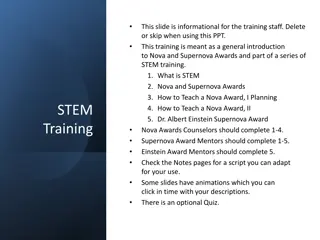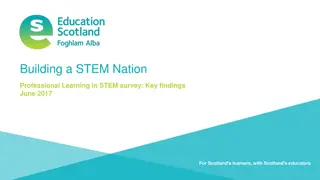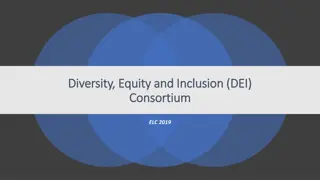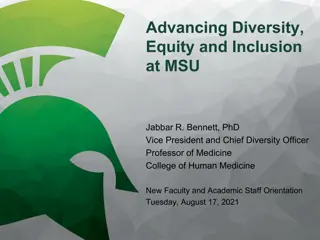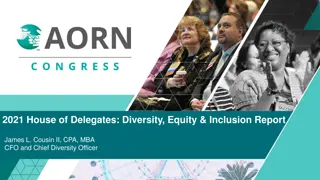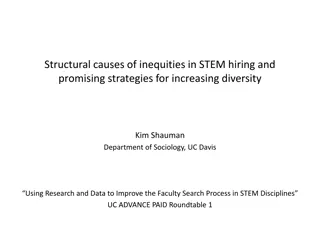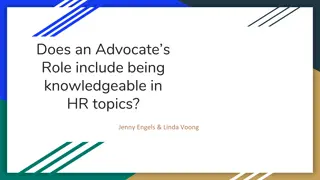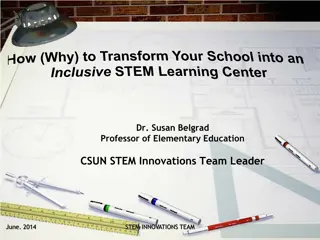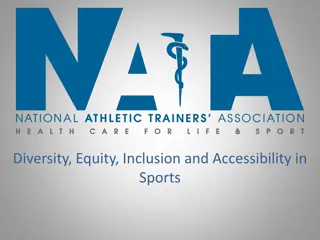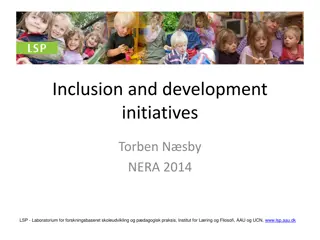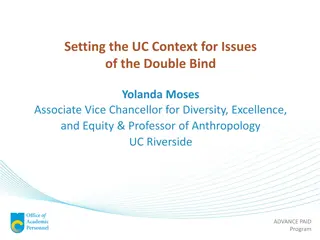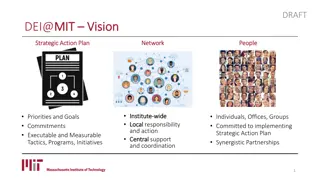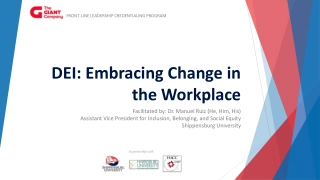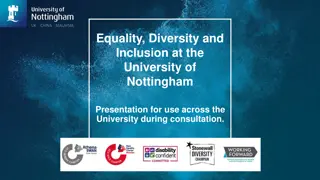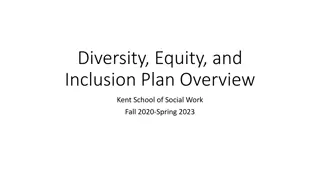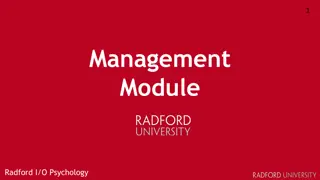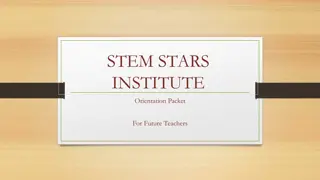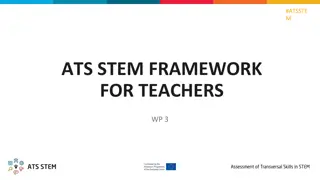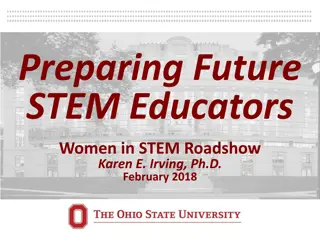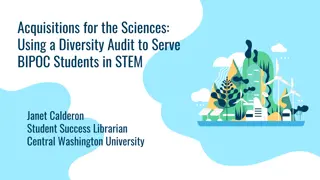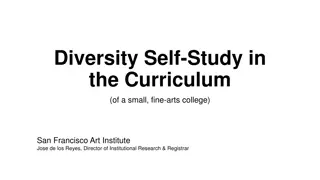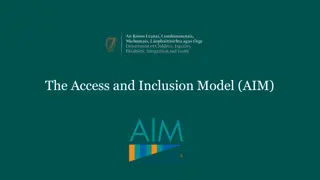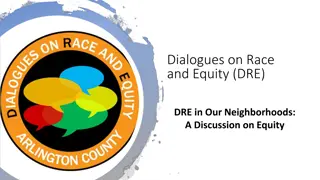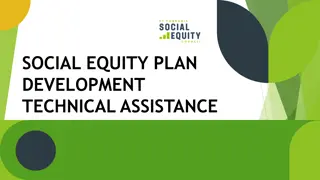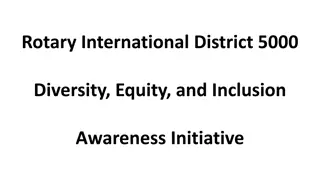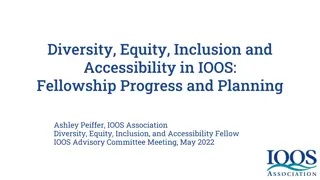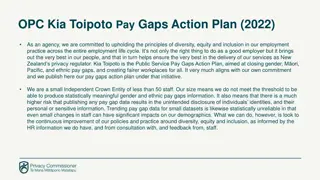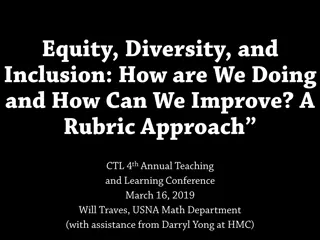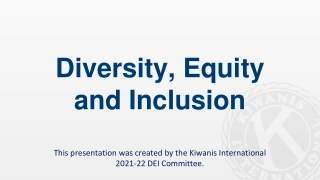Diversity, Equity, and Inclusion Advocates in STEM
Philip (Phil) Abitua, PhD, and Osama (Sama) Ahmed, PhD, are passionate advocates for diversity, equity, and inclusion in STEM fields. Phil focuses on empowering underrepresented minority postdocs and enhancing their success as junior faculty, while Sama mentors undergraduates and promotes peer mentoring circles to support marginalized scientists. Both have extensive experience in academia and research, contributing to creating more inclusive environments and opportunities for underrepresented groups in science.
Download Presentation

Please find below an Image/Link to download the presentation.
The content on the website is provided AS IS for your information and personal use only. It may not be sold, licensed, or shared on other websites without obtaining consent from the author. Download presentation by click this link. If you encounter any issues during the download, it is possible that the publisher has removed the file from their server.
E N D
Presentation Transcript
Philip (Phil) Abitua, PhD Action toward Diversity/Equity Inclusion elected as the State (Texas) Director for the Texas League of United Latin American Citizens (LULAC) Youth program. 2020 elected as the Diversity Officer for the Pan-America Society of Evolutionary and Developmental Biology (PASEDB). As the Diversity Officer, my primary goal is to create an award and mentoring program for underrepresented minority postdocs that seeks to empower them to succeed as junior faculty. Teaching undergraduate lab assistant for a Cellular and Molecular Biology Lab course at UT Austin. In the summer of 2011, I was a teaching assistant for the ascidian module of the Woods Hole Embryology course: demonstrated the electroporation technique, assisted with microscopy, and answered students questions on Ciona development. As a grad student instructor at UC Berkeley, taught a Cell Biology and Physiology Lab course. Responsibilities included meeting with other instructors in advance to troubleshoot the labs, giving a short lecture ahead of each class, running the 4-5 hour labs with students, and grading lab notebooks and reports PhD- UC Berkeley Damon Runyon Post-doc Harvard Research Studies the development of the African turquoise killifish, Nothobranchius furzeri, a novel model organism to investigate cell migration in vivo. He seeks to understand how cells aggregate through a mesenchymal to epithelial transition (MET) during embryogenesis. Using light sheet microscopy, he will image and analyze this highly dynamic phenomenon to make predictions about how cells decide to change their behavior during MET, an understudied process that is casual for malignancy.
Osama (Sama) Ahmed, PhD Action toward Diversity/Equity Inclusion served as primary mentor to 11 undergraduates, of whom 6 have co- authored papers with me and several have matriculated into MD/PhD programs. an exponent of Peer Mentoring Circles[2] (PMCs), wherein small groups of peer-scientists receive and provide horizontalized support. PMCs are a powerful diversity and inclusion mechanism that buffers against the isolation and tokenization experienced by marginalized scientists spoke openly about his experiences as a Black scientist at our graduate program s town-hall and in a highly-distributed podcast produced by The Fog at Bay. These experiences resonated with scientists at numerous institutions and provided space for me and others to build more inclusive programs. founded a science podcast called Carry the One Radio, now in its 11th year, to encourage young scientists of color to pursue graduate education in STEM fields PhD- UCSF BWF PDEP, BRAINS Post-doc Princeton Research Uses genetic, neural, and behavioral approaches to behavior in Drosophila. This work combines neuroscience tools with a focus on evolutionary questions. His postdoctoral research focuses on courtship behaviors, including acoustic communication, and he has now added cutting-edge experimental and computational methods to the genetic and behavioral approaches he used as a grad student. Teaching As a mentor, I embolden students to support each other through group-work, to actively participate in their own education, and to re-imagine their roles through scientific outreach. To succeed, I pull from evidence-based teaching approaches1,2 and my personal experiences as a course instructor, a science podcaster, and a mentor. I am eager to continue learning and adapting new pedagogical methods for creating safe, decolonized learning spaces.
Action toward Diversity/Equity Inclusion While a graduate student at Northwestern University, he wrote a community building grant with a fellow graduate student Koshonna Brown. With this grant, they created the Chicago Graduate Students of Color Association (CGSCA). The goal of the organization was to foster camaraderie and establish a support system among graduate students of color, on Northwestern University s Chicago campus. As a postdoctoral fellow at UT Southwestern, he is post-doctoral advisor to The Association of African American Scientists (TAAAS), a graduate-student organization. In this capacity, he provides mentoring and support to the African-American graduate students on campus. Teaching As mentor for Science Club, he was tasked with introducing a number of students from a local elementary school to complex scientific concepts. Each week, he would guide a small group of adolescents through a series of science projects based on an overriding theme. Before each session, he would greet the students with a preliminary multiple-choice question. John Brooks II, PhD PhD- Northwestern Post-doc UTSW HHMI Hannah Gray Fellow Research His work shows that diurnal functions of the microbiota can entrain rhythms in host immunity, and further, that rhythms in host immunity can impact host-pathogen interactions across the day-night cycle. This work led to a fundamental question concerning intestinal epithelial biology. Are other immune functions within the epithelium regulated diurnally, and if so, what impact do these diurnal immune functions have on host microbe dynamics? His independent research program will mechanistically determine how host-microbe dynamics are impacted across the day-night cycle. Long-term his laboratory will characterize diurnal rhythms in host immune functions to an extent where we could manipulate these rhythms for the benefit of host health.
Action toward Diversity/Equity Inclusion In Atlanta (2015-2019), volunteered to provide science tutoring once a week at the Global Village Project, the only US school designed to meet the unique needs of refugee girls and young women with interrupted education sought opportunities to engage with inner city high school students to share and answer questions about my research and career path volunteered once a week to provide extracurricular training to kids with refugee/immigrant backgrounds in Oslo, Norway. Teaching Courses developed so far include in-person classrooms, remote classrooms, and hands-on laboratory and field practical sessions. These have been tailored to a variety of groups, from students at formal institutions of learning, with diverse backgrounds including those from historically underrepresented groups and across all tertiary education levels; to field and laboratory technicians and scientists at research/public health institutions. Malaria Prevention, Control and Treatment Course (GH574) at the Rollins School of Public Health Global Health Program at Emory: mosquito biology class lectures and hands-on laboratory sessions. She taught the course to Emory graduate students enrolled in the program, as well as adapted it for the CDC s Epidemic Intelligence Officers and Resident Advisors. Nsa Dada, PhD PhD- Norwegian University of Life Sciences Post-doc CDC/Emory Researcher. Tropical Infectious Diseases Research Center, University of Abomey- Calavi, Benin Adjunct Research Fellow. Nigerian Institute of Medical Research, Lagos, Nigeria Leader, Mosquito Microbiome Consortium Research Focus is on mosquito-microbe interactions, their effects on the evolution of insecticide resistance in vector mosquito populations, and the implications for disease transmission and control. Insecticide resistance is an increasing threat to vector- borne disease control efforts, and the mechanisms underlying its evolution in vector mosquito populations are not understood. Based on evidence of microbe-mediated resistance to orally and topically administered insecticides in agricultural pests, she has been testing the hypothesis that microbes (host or environmental) could also be mediating insecticide resistance in mosquitoes. Creative use of omics and bioinformatics approaches to test these ideas
Action toward Diversity/Equity Inclusion Taught at City College of New York (CCNY), most students were from underrepresented groups and many were first-generation students. Many had significant work or family obligations; some students couldn t afford the textbook. She realized that poorly performing students are often just as hardworking and intelligent as A students but are burdened with these disadvantages. At Columbia co-founded a new postdoctoral seminar series and insisted on equal gender representation even when the nominations were heavily male-biased. Advocated for more diversity while serving on my department s extramural seminar committee (see my blog post: http://www.brains- explained.com/seminar-speaker-selection-a-casestudy-of-gender- bias-in-science). Participated in numerous outreach efforts to inspire scientific interest in students from disadvantaged backgrounds. Led hands- on activities at community science fairs and schools. Teaching Course Instructor: City College of New York, New York, NY 1/2018 5/2018: BIO 35400: Introduction to Neurobiology (advanced undergraduate course, ~50 students); also has taught Genetics and NeuroBio II at the same place in a similar format. Volunteer Classroom Teacher: Bronx Writing Academy, New York, NY 1/2015 5/2015: Ten-week sixth grade neuroscience class through Citizens Schools program serving underperforming public schools (~15 students) Anita Devineni, PhD PhD- UCSF Post-doc Columbia Research An animal s survival depends on interpreting cues from the external world and selecting an appropriate behavioral response, such as hiding when a predator s scent is detected. Moreover, behavioral flexibility is crucial for survival. For example, a hungry animal may prioritize finding food over staying hidden. A fundamental challenge in neuroscience is to understand how the brain integrates internal and external cues to generate flexible behavior. She uses the taste system to understand how the brain integrates external and internal cues for flexible behavior. Her research plan addresses two aspects of taste that have been largely unexplored: state-dependent flexibility and behavioral complexity. While the field has focused on how taste regulates feeding, my research will investigate how animals use taste cues to guide more complex behavior while also integrating internal signals such as hunger, experience, and reward.
Michael (Mike) Gil, PhD Action toward Diversity/Equity Inclusion During my postdoc, he served as a student-elected mentor, providing STEM career advice, for the undergraduate program Strategies for Ecology Education, Diversity and Sustainability (SEEDS). Serves as an appointed member of the inaugural Diversity, Equity, and Inclusion Committee for the Western Society of Naturalists, tasked with making the society and its annual meetings more accessible and welcoming to trainees from groups that are underrepresented in STEM fields. To make science more inclusive of everyone, not just college students, he launched a campaign in September 2015, SciAll.org, centered on free videos and public talks that highlight research in action and provide an insider s take on the lives and careers of scientists. The videos have been watched for >20,000 hours (on YouTube alone) and have improved perceptions about science among female and minority viewers. Teaching In 2011, I volunteered to help develop the curriculum for and teach a research-intensive field course (Marine Botany, University of Texas at Austin) in Akumal, Mexico (taught 2011, 2013, 2015, and 2017). I went on to create and offer my own course (Marine Ecology, University of Florida) focused on the ecology of coral reefs, in French Polynesia (2014) and Mexico (2016 and 2018). PhD- U Florida Post-doc U Colorado (prior at UC Davis and UC Santa Cruz) Research How does environmental change shape ecosystems? Our fundamental understanding of nature and our ability to sustain critical ecosystem services rest upon the answer to this question. Growing evidence suggests that the answer may hinge on animal behavior. Animals can rapidly shift their behavior in response to environmental change and the actions of others, at timescales far shorter than demographic timescales. He develops high- throughput data collection systems in the field to rigorously and objectively identify animal behaviors and their drivers, and combine these methods with statistical, analytical, and computational models to produce data-driven answers to the question: how does animal behavior shape ecological responses to environmental change?
William Gilpin, PhD Action toward Diversity/Equity Inclusion mentored early career doctoral students with nontraditional academic backgrounds as part of the EDGE-STEM program organized and taught educational workshops each year as part of my research group s Microscope for every child project. These workshops involved teaching students at local primary schools (and their curious parents) how to create and use the Foldscope, a $1 paper microscope invented in my advisor s laboratory Teaching At Stanford, he assisted in re-developing an introductory soft matter physics course for bioengineers; years of Khan Academy Clear evidence of successful mentoring a diverse group of trainees. PhD- Stanford Applied Physics Post-doc Harvard Research He points out that in evolution, development, and behavior, there is a similar emergence of a relatively low dimensional function from a very large dimensional dynamics on the mechanistic level (e.g., stereotypical movements or relatively few phenotypes). Is this inevitable or a result of evolutionary optimization? Of learning? Of the physics of the surrounding world? To answer this, he works with specific experimental data across extremely diverse model systems, answers specific questions, and then generalize from the answers across domains of biology. His creative application of machine learning, physics, applied math across the entire breadth of biology is unquestionably unique for someone at his career stage. Some of our theorists agree that he is a "once in few years in the whole world" bio-theorist. (from Ilya)
Rebecca Helm, PhD Action toward Diversity/Equity Inclusion Began working on issues of gender inclusion as a graduate student, where she led a successful campaign to create a gender neutral bathroom in her department. introduces her dyslexic status on the first day of every new class and shares how much it impacted her as a student. She is intimately aware of the power stereotyping and stigmatization can have on a person. She invites students to share any of their own struggles (if they choose to) in their first homework assignment Over 30% of UNCA students identify as non- straight or non-binary, so she supports a very diverse group of current students Teaching For the last two years, she has been a faculty member at UNC-A with primary teaching as her main role- super creative approaches! My core values as a professor are to create community, curiosity, and connection. Below, I outline how I have incorporated each of these values into my classroom, and the future mentoring I will do at Emory. PhD- Brown Post-doc Woods Hole Asst. Prof UNC Asheville Research The open ocean covers roughly 45% of the Earth s surface, yet remains poorly known. She studies the evolution and ecology of the open ocean, from the molecular and developmental mechanism correlated with evolutionary radiations into open ocean habitat, to the distribution of oceanic species. Her research program is composed of two parts: using jellyfish as a model system to study the developmental underpinnings of open ocean evolution, and studying the ecosystems at the open ocean s surface. In addition, she is active in outreach and policy to ensure this habitat is valued and protected.
Ryan Insolera, PhD Action toward Diversity/Equity Inclusion Volunteering in the Developing Future Biologists (DFB) program and participating in the growth and success of this program at the University of Michigan was the most rewarding DEI-oriented outreach activity in which he has participated. He is a proponent for compensating students for their time in the lab. The freedom to volunteer in a research lab is not shared by all, and more often creates a barrier. He has committed to this principle as a postdoc, as he is currently employing a work- study undergrad student from his fellowship funds to assist in my project as she pursues an undergraduate honors thesis. Teaching During postdoctoral work, he volunteered to substitute for instructors in their courses including Synapses (MCDB 351) and Neurobiology of Sexual and Aggressive Behaviors (MCDB 457); small-group discussions covering research papers pertaining to the subjects of the course and created quizzes on the papers discussed in those classes. In 2017, he taught a semester-long 300-level biology course at neighboring Eastern Michigan University. He volunteered as an instructor/organizer for the educational outreach program Developing Future Biologists (DFB, see www.developingfuturebiologists.com, educational paper in pre- print (https://doi.org/10.1101/467092)) for two years. PhD- Cornell Post-doc U Michigan K99 Research Almost nothing is known about mitophagy in neurons within their physiological context in the nervous system. Using the knowledge he has generated in his postdoctoral research and the powerful genetic tools available in the model organism Drosophila, the overall focus of my lab will be to: 1) understand the cell biological and physiological consequences of the failure of mitophagy in neurons; and 2) systematically discover novel molecular mediators of mitophagy in neurons in vivo.
Eduardo Javier (Javier) Lpez Soto, Ph.D. Action toward Diversity/Equity Inclusion Organized a mini-symposium at the 2019 SfN meeting that included six impressive early career investigators as speakers which included female, queer, and international scientists. At Brown, established BrainExPo, a seminar series to highlight early career investigator work among members of the Carney Institute for Brain Science. BrainExPo fosters a sense of community among postdocs, and encourages scientific exchange and professional development; has a strong commitment to invite a diverse group of scientists and promote exposure and visibility of minorities and women Teaching For five years, he has served as an instructor for Neuropracticum, a high-intensity course for Brown University's first-year Neuroscience graduate students learning various core state-of-the-art techniques through hands-on rotations. At Brown University, he was a lecturer for two undergraduate courses. Both classes, attended by interdisciplinary undergraduate students and held virtually due to the pandemic, challenged him to ensure lesson plans were now attuned to a virtual and broad audience. PhD- National University of La Plata, Argentina Post-doc Brown (K99/Warren Alpert Fellowship) Research His research plan interrogates cell-specific alternative splicing, its contribution to pain signaling and how disrupted splicing contributes to the pathophysiology of neuropathic pain. He will work at the intersection of genomics, neurophysiology and behavior to 1) identify cell-specific splicing events and regulatory networks in sensory neurons; 2) study the role of cell-specific isoforms in pain signaling in normal and disease states; and 3) develop therapeutic tools to normalize splicing after injury. This work is groundbreaking in connecting molecular pathways with specific cell type-specific functions
Micaela Martinez, PhD Action toward Diversity/Equity Inclusion After receiving the NIH Director s Early Independence Award, she had the confidence to out herself as the daughter of an incarcerated individual, and someone who climbed up the ranks from community college to the Ivy League. Expert witness in a federal lawsuit regarding the reporting of race and ethnicity for COVID-19 cases, hospitalizations, and deaths nationwide; working with civil rights lawyers to push the Trump-appointed heads of the CDC and Health and Human Services to enforce laws regarding the states reporting of notifiable infectious diseases by race and ethnicity. Teaching Graduate level course on Climate Change & Human Health within the Columbia University Mailman School of Public Health: 12-25 students with focus on how climate change impacts health both directly and indirectly by way of infectious diseases, forced migration, food instability, air pollution, climate and conflict, and extreme weather events. I also teach a summer course called Mathematical Models of Infectious Diseases, which is a course for graduate students and postdocs through the University of Washington Summer Institute in Statistics and Modeling in Infectious Diseases (SISMID). PhD- U Michigan Post-doc Princeton (NSF) Asst. Prof Columbia Research Focus of her lab is deconstructing epidemics. The shape, frequency, and magnitude of epidemics collectively contain information about host-to-host transmission, immunity in the population, and importation of infection; uses cutting-edge statistical methods and dynamic models to extract that information. Traditional training in biology, coupled with my research in computational and applied mathematics and statistical inference, has allowed her to develop her unique expertise: leveraging epidemiological and clinical data to unmask population-level biological processes that impact human health. Her ongoing research falls into four themes: (1) seasonal disease transmission, (2) maternal immunity, (3) the realized effects of vaccines, and (4) human biological rhythms in the Anthropocene.
Nicole Martinez, PhD Action toward Diversity/Equity Inclusion Through Upward Bound Math and Sciences at UPenn and Health Professionals Recruitment and Exposure Program at Yale, she has supported high school URMs in pursuing STEM degrees and careers. She is part of her department s Committee on Climate and Diversity to improve diversity and inclusivity in the department at the undergraduate, graduate and faculty level. One initiative the committee is pursuing to enhance graduate recruitment of URMs is to launch a virtual recruitment seminar series Teaching At Yale University she guest-lectured in the graduate level Advanced Eukaryotic Molecular Biology course. She curated lecture materials about pre-mRNA splicing and incorporated active learning components. She designed lecture and lab-based lessons for the UPenn Upward Bound Math and Sciences program. For, example she taught high school students about RNA secondary structure by using an active learning approach were we first introduced the principles of RNA folding in a lecture and had students play a computer game where they folded the RNAs applying the concepts they learned. PhD- U Penn Post-doc Yale (K99) Research Her research focuses on the impact of a novel post- transcriptional modification of mRNA- pseudouridine. The methods to detect this modification were developed in her mentor s laboratory so she is one of the few in the world who can ask these questions. She has identified specific molecular consequences of these modifications that she will study in her own research group. Mutations in the genes that deposit this modification cause human disease. She has top notch collaborations that allow her to ask questions no one else in the world will pursue.
Jess Romo, PhD Action toward Diversity/Equity Inclusion Reactivated a Society for Advancement of Chicanos/Hispanics and Native Americans in Science (SACNAS) chapter and served as president for 3 consecutive years Mentored hundreds of high school students from low income institutions on science fair projects, career trajectories, and college transitions; directly mentored undergraduates from programs such as McNair, Louis Stokes Alliances for Minority Participation (LSAMP), PREP, McNair, etc.. Part of the leadership for Scientists Promoting INclusive Excellence in Science (SPINES), a grassroots organization to create a welcoming and diverse environment at Tufts. Designed a course entitled Science in All Colors , at UMass Boston in the Fall of 2020 to focus on the contributions of scientists from underrepresented backgrounds placed in a historical and political context Teaching Tufts IRACDA Biology Faculty, Galen College of Nursing, San Antonio, TX 2012 2019, Microbiology Lecture and Laboratory (50 students per quarter); Anatomy and Physiology (50 students per quarter) STEM Outreach Coordinator, Department of Biology, Center of Excellence in Infection Genomics (CEIG) and South Texas Center for Emerging, Infectious Diseases (STCEID), UT San Antonio 2010-2018; Directed microbiology community outreach PhD- UT San Antonio Post-doc Tufts (IRACDA) Research Discovered that C. glabrata, an under-studied member of the GI mycobiome, exacerbates C. difficile infection (CDI) in a murine model of infection by accelerating disease onset; C. glabrata and C. difficile also form robust and enhanced biofilms in vitro and the presence of both organisms leads to the production and secretion of cell wall-like components that appear to impact C. difficile metabolism. These observations highlight the urgent need to understand the role of the gastrointestinal mycobiome in human health and disease. Therefore, the goal of the Romo lab is to analyze how bacterial infection (i.e. CDI) impacts the composition of the host mycobiome, identify fungal-bacterial pathogen interactions critical to host health and disease, and reveal the mechanisms that mediate these interactions.
Angeles (Angie) Salles, PhD Action toward Diversity/Equity Inclusion Johns Hopkins Psychological and Brain Sciences Department diversity initiative (PBS Action) that I hope will have a long-lasting impact on the University s inclusion strategies for underrepresented minorities. Within PBS Action, I am part of the Hiring and Recruiting work group whose aim is to increase the representation of minorities at every level within the department Mentored over a dozen students from different backgrounds and each one contributed their unique and enriching perspective on the research. Teaching Participated in the Teaching Academy at Hopkins Taught at the University of Buenos Aires; designed in full and taught an advanced neuroscience course for undergraduates. The course I designed was titled Choosing the champion animal for neuroscience research . During the fall semester of 2018 I taught this course and implemented a Q & A discussion strategy, which was an extremely enriching experience. PhD- University of Buenos Aires (Argentina) Post-doc Johns Hopkins (HFSP Fellow) Research Combine neurophysiology and molecular tools in echolocating bats to investigate auditory processing of complex sounds and vocal learning. There are limits to invasive methodologies to study the neural mechanisms of natural sound processing and vocal learning in humans, but animal models allow us to overcome these barriers and unravel processes that mediate natural sound processing, which, in some species, gives rise to vocal learning. Until now, most neurobiological studies of vocal learning have focused on birds, yet the differences in brain structures between birds and mammals leave many unanswered questions about the generalization of these research findings. Developing comparative studies in mammals can help dissect which processes and mechanisms are shared across species, and which mechanisms are class-specific
Sergey D. Stavisky, PhD Action toward Diversity/Equity Inclusion During graduate school, he taught local 7th grade students through Stanford s Brain Day and SIMR diversity-promoting undergraduate summer program. I am currently a mentor in Stanford s FLI (first-gen and/or low income) Community Mentor Program. Commit to ongoing learning about obstacles put in front of URM students, and effective strategies to reduce these barriers. As an immigrant, I am well-tuned to many of this community s specific challenges, but I have not lived the specific challenges faced by BIPOC, women, disabled, or LBGTQ scientists. I will self- educate and step up so that DEI efforts do not fall primarily upon URM academics, which is the current status quo. Teaching Co-created from scratch and taught Stanford's Analysis Techniques for the Biosciences using MATLAB course (NENS230) together with a fellow student. Taught and mentored extensively in the lab: I have been the primary day-to-day mentor for five undergraduates, an MD student, three PhD students, a clinical technician, and a research engineer. PhD- Stanford Post-doc Stanford (BWF Career Award) Research Brain-computer interfaces (BCIs) are poised to profoundly transform human neuroscience and health by treating devastating and currently incurable nervous system injuries and diseases with precise, circuit-level measurements and interventions. BCIs can potentially restore the ability to speak, move, remember and more. However, going from proof-of-concept studies in animal models to repairing or replacing patients damaged abilities requires a platform for understanding human-specific neural functions and designing, testing, and refining therapies in people. His strategy for accomplishing this is to initially develop advanced intracortical BCIs to restore speech and reach & grasp movement for people with paralysis.
Thomas (Tom) Stewart, PhD Action toward Diversity/Equity Inclusion Extensive experience mentoring students from groups historically excluded from the sciences: McNair Scholars Program (GREs and their academic conferences), Chicago Multicultural Connection (advising undergrads on grad school applications), Brothers for Science (middle school boys from the Kenwood community in Chicago), and the Broadening Participation Committee of the Society for Integrative and Comparative Biology. Designed a spring break program on neuromechanics for high school students in Chicago through the Museum of Science and Industry; conducts outreach through the Field Museum of Natural History Teaching Faculty instructor at Yale University (2016-2017: Comparative Vertebrate Anatomy, a laboratory- based course) and Columbia University in the City of New York (2020: Fundamentals of Evolutionary, a graduate student seminar). Produced an hour long, bi-weekly show on Chicago public radio (WHPK 88.5). PhD- U Chicago Post-doc U Chicago (prior Yale and U. Minn) Research Studies major phenotypic transitions in vertebrate evolution, how anatomical features originate and how morphological diversity is generated. I integrate a variety of approaches (evolutionary developmental, paleontological, and functional morphological) to understand macroevolutionary patterns of vertebrate diversity and to inform evolutionary theory. Major projects focus on: 1) the origin of fins 2) fin-to-limb transition, and 3) the diversification of limbs.
Michael (Mike) Wells, PhD Action toward Diversity/Equity Inclusion As a graduate student I spent several years fostering a love for science in young children from minority groups through the BOOST (Duke University) and TTT Mentors (MIT) programs As a postdoctoral fellow, he launched the COVID-19 National Scientist Volunteer Database (covid19sci.org), which is an organization he created in part because of concerns that the pandemic would disproportionately affect individuals from lower-income and minority groups. Teaching Spring of 2018 when I was the lead teaching fellow for a hands-on laboratory course offered for the first time at Harvard. Fifteen talented sophomores were given the opportunity to generate and characterize the effects of CRISPR-mediated mutations on human stem cell-derived neurons. I helped devise the curriculum from scratch, assessed student performance, registered feedback, and provided instructive critiques to administrators regarding areas of improvement. PhD- Duke Post-doc Harvard (K99 and BWF PDEP) Research Understand the genetic and molecular factors that contribute to the immense diversity of human neurological and psychological traits. Differences in the way we think, act, and feel arise in part during the earliest stages of brain development, though we currently know little about how genetic variation impacts the cellular and molecular mechanisms that underlie these traits. He has used a wide range of techniques and models, including CRISPR screens in human stem cell-derived neural cells and circuit dissections of behavior in gene-altered mice. His laboratory will elucidate the role of genetic variation on neuro- developmental outcomes by quantifying the effects of genetic heterogeneity and disease-associated mutations on major molecular pathways, neuronal circuit formation, and complex mammalian behaviors.
Damien Wilburn, PhD Action toward Diversity/Equity Inclusion As part of the UW Genomics Salon (a Genome Sciences-based forum for topics that lie at the intersection of science and the public), I recently led a discussion on heteronormativity and science. While individuals in academia and STEM-based fields are overwhelmingly politically liberal, as of 2015, ~43% of LGBTQ adults in the STEM workforce remain closeted at work, which is thought to be the result of a culture of disconnectedness and toxic masculinity. Involved in the Pacific Science Center s Life Science Research Week where researchers in the Seattle area connect with younger children and the community. Teaching Received the 2017 Outstanding Postdoc Mentoring Award from the UW Graduate School and was an invited speaker during the 2017 UW Biomedical PhD Hooding Ceremony. Taught and mentored extensively in the lab, including many trainees from groups traditionally underrepresented in STEM fields. PhD- U. Louisville Post-doc/Acting Director Genome Science- Univ. Washington (K99) Research Evolutionary biochemist who specializes in reproductive biology and studies the evolution of species-specific interactions between male-female proteins. Genes associated with reproduction evolve at extraordinary rates through direct and indirect sexual selection. Rapid evolutionary rates serve as innovative signatures of functional significance but can also confound homology detection between diverse animal clades. Protein tertiary structure shows greater conservation than primary sequence, and many reproductive proteins share 3D topologies despite undetectable sequence similarity. A core component of my research is the use of high field multidimensional NMR to study reproductive protein structure and molecular dynamics including protein/protein interactions.
Luis Zaman, PhD Action toward Diversity/Equity Inclusion Participated in the Sloan program in many ways, including acting as a mentor for new recruits, organizing biweekly meetings, and planning social events. Through my involvement, he was recommended for, and awarded, an Alfred P. Sloan Ph.D. Fellowship. Maintained his involvement with the Sloan foundation through the Sloan Scholars Mentoring Network, which aims to create a community of prestigious scholars dedicated to creating inclusive and nurturing climates in academia. As part of a NESCent working group on increasing diversity in evolutionary biology, he mined data published by the NSF to get a more quantitative view of the problem Teaching As an LSA Collegiate Fellow at University of Michigan, I developed a new course called Evolution in silico (CMPLXSYS 425) and have continued to grow its enrollment. Currently teaching a new class for the EEB department, "Ecology and Evolution of Infectious Diseases" (EEB 315). PhD- Michigan State Post-doc U Washington Asst Prof U Michigan Research Parasites and their hosts have a tumultuous and asymmetric relationship that embodies the significance of biotic interactions on evolutionary dynamics. While parasites rely on their hosts to produce new infectious offspring, hosts have a vital interest in evading infection. Adaptations in one population create selection pressures for counter-adaptations in the other. Although this co- evolutionary push-and-pull is intuitively simple, it is thought to be a driver of many critical ecological and evolutionary processes such as the maintenance of diversity and sexual reproduction, the evolution of complex traits, and the evolution of virulence. He uses computational, mathematical, and microbial (e.g., bacteria-bacteriophage) model systems. The long-term goal of his research is to understand, and ultimately predict, fundamental ecological and evolutionary responses within complex communities.
Yana Bromberg, PhD Action toward Diversity/Equity Inclusion Mentored and supported many trainees from diverse groups including women in data science. Contributed to NASA-sponsored outreach activities in local elementary and middle schools and even produced a cartoon version of our work for younger students (>1,800 views in the past month, https://www.youtube.com/watch?v=DGTPPy2fNyc). Working with kids was a wonderful experience that I plan on repeating at Emory. Teaching Aside from the Bioinformatics course, she developed an undergraduate Astrobiology course at Rutgers, where a number of faculty lecture on applicable topics. She introduces the full diversity of students (astronomy, physics, math, geology, biology, etc.) to mutations and evolution, highlighting the evolutionary record in more permanent structures, e.g. geological record. Additionally, I consistently guest lecture in courses at Rutgers and the Technical University of Munich, and lead a week-long bioinformatics immersion course as part of the International Master s Program at University of Bologna. PhD- Columbia Post-doc Columbia Associate Professor, Dept of Biochemistry and Microbiology Rutgers Univ., School of Environmental and Biological Sciences (New Brunswick) Research Develops bioinformatics approaches to understand molecular function, in particular, in micrbiomes in health and disease. While most other researchers focus on identifying which species are present in metagenomic samples, she looks at a microbiome as a cohesive organism, characterized by a set of functions, performed collectively. She has shown that, at least in some cases, the functional profile of a microbiome is a lot more stable and more meaningful than its composition. This functional, rather than compositional, approach to microbiomes is, essentially, unique. (from Ilya)
Action toward Diversity/Equity Inclusion Member of the Biology Inclusion Committee and have been personally involved in efforts to improve the culture and atmosphere of our department, including recent efforts to change the protocols of our hiring committees. Volunteered in an after-school program for African American and Latino kids known as SALSA (Seeing and Learning Science After school) in Carrboro, NC, and I served in diversity panels at the meetings of the Society for the Study of Evolution (2010) and the Society for the Advancement of Hispanics, Chicanos, & Native Americans in Science (2011). Teaching Teaches an upper-level laboratory on the evolution of animal behavior at Wash U and a 1-credit seminar introducing undergraduate students to primary research in ecology and evolution. The lab course includes an introduction to R computing and an in- depth review of general linear models, a module on game theoretical analyses of animal fights (using crickets as an experimental system), a module on phylogenetic comparative methods, and a module on evolutionary simulation modeling Carlos Botero, PhD PhD- Cornell Post-doc NC State Asst Prof Wash U Biology (near tenure) Research Quantitative evolutionary ecologist interested in how organisms cope with and adapt to variable and unpredictable environments. His research is focused on understanding the functional implications of fluctuating selection in three general realms: (1) Organismal adaptation to climate change (2) The eco-evolutionary dynamics of cognition; and (3) The evolution of human culture. He is approaching these topics from a broad phylogeographic perspective, often as the leader of collaborative teams that span multiple disciplines and institutions. In each of these fields he seeks to answer fundamental questions using theoretical modelling, comparative analyses, and experiments in the lab and the field.
Additional Candidates 2 women 1 man Nyasha Chambwe, PhD- (St. Judes) -uses computational methods to study genomic and molecular alterations in cancer to understand factors that drive disease incidence, progression and therapeutic response Millie Rinc n-Cort s, PhD- (U Pitt) understand how brain reward pathways influence and interact with neural systems implicated in depression and addiction, and how these are modulated by environmental influences Carlos Taboada, PhD (Duke)- to understand the complex interplay of the physiological and biochemical processes that determine animal coloration from a cross- disciplinary perspective Self-identify as: 1 Black 2 LatinX



